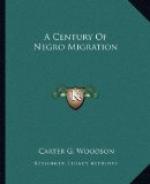[Footnote 28: Davidson and Stowe, A Complete History of Illinois, pp. 321, 322; and Washburn, Edward Coles, pp. 44 and 53.]
[Footnote 29: The Negro population of this town so rapidly increased after the war that it has become a Negro town and unfortunately a bad one. Much improvement has been made in recent years.—See Southern Workman, xxxvii, pp. 489-494.]
[Footnote 30: Still, Underground Railroad, passim; Siebert, Underground Railroad, pp. 34, 35, 40, 42, 43, 48, 56, 59, 62, 64, 70, 145, 147; Drew, Refugee, pp. 72, 97, 114, 152, 335 and 373.]
[Footnote 31: The Journal of Negro History, I, pp. 132-162.]
[Footnote 32: Ibid., I, 138.]
[Footnote 33: Olmsted, Back Country, p. 134.]
[Footnote 34: In the Appalachian mountains, however, the settlers were loath to follow the fortunes of the ardent pro-slavery element. Actual abolition, for example, was never popular in western Virginia, but the love of the people of that section for freedom kept them estranged from the slaveholding districts of the State, which by 1850 had completely committed themselves to the pro-slavery propaganda. In the Convention of 1829-30 Upshur said there existed in a great portion of the West (of Virginia) a rooted antipathy to the slave. John Randolph was alarmed at the fanatical spirit on the subject of slavery, which was growing in Virginia,—See the Journal of Negro History, I, p. 142.]
[Footnote 35: Adams, Neglected Period of Anti-Slavery.]
[Footnote 36: The Journal of Negro History, I, pp. 132-160.]
[Footnote 37: Siebert, Underground Railroad, p. 166.]
[Footnote 38: Adams, Neglected Period of Anti-Slavery.]
[Footnote 39: Siebert, Underground Railroad, chaps. v and vi.]
[Footnote 40: An Address to the People of North Carolina on the Evils of Slavery.]
[Footnote 41: Washington, Story of the Negro, I, chaps. xii, xiii and xiv. ]
[Footnote 42: Father Henson’s Story of his own Life, p. 209; Coffin, Reminiscences, pp. 247-256; Howe, The Refugees from Slavery, p. 77; Haviland, A Woman’s Work, pp. 192, 193, 196.]
[Footnote 43: Woodson, The Education of the Negro Prior to 1861, pp. 236-240.]
[Footnote 44: The United States Censuses of 1850 and 1860.]
CHAPTER III
FIGHTING IT OUT ON FREE SOIL
How, then, was this increasing influx of refugees from the South to be received in the free States? In the older Northern States where there could be no danger of an Africanization of a large district, the coming of the Negroes did not cause general excitement, though at times the feeling in certain localities was sufficient to make one think so.[1] Fearing that the immigration of the Negroes into the North might so increase their numbers as to make them constitute a rather important part in the community, however, some free States enacted laws to restrict the privileges of the blacks.




